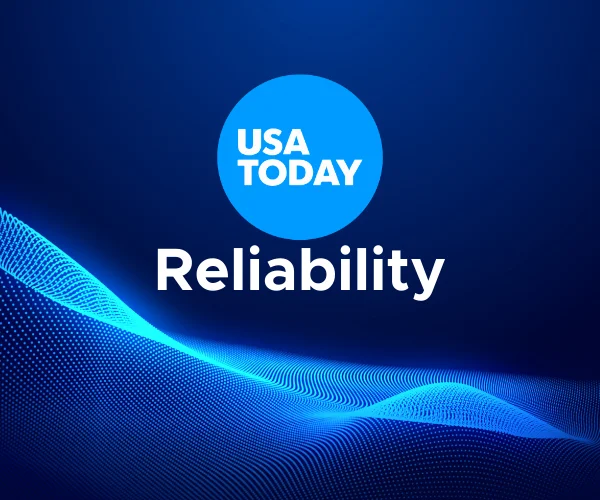
In a 2021 survey from the Reuters Institute, USA Today was ranked as the 9th most trusted news organization. According to Reuters, 43% of people surveyed trust USA Today, while only 31% do not trust it. Interestingly, 26% of respondents replied as neither trusting nor distrusting USA Today, giving the media organization a high value of trust within the journalism community.
Considering its reputation, the publication at USA Today is not always accurate. It has been praised for doing an excellent job of mitigating erroneous or biased articles. Is USA Today as trustworthy and perfect as people believe? At Biasly, we endeavor to evaluate the accuracy and dependability of all media outlets. Let us investigate the reliability and accuracy of USA Today.
Source: Reuters Institute
Does Reliability Matter?
Reliability, in general, refers to how trustworthy or accurate information, or in this case, a news source is. If we consider this definition, it quickly becomes clear why reliability is important in media sources. If we can’t trust the things we read then there isn’t much of a point in continuing to consume content from that source, after all. So how exactly can we gauge the reliability of a news source anyways?
There are several potential measures of reliability to look out for when trying to determine whether a media source is reliable or not. Red flags for an unreliable article can include the presence of wild unsubstantiated claims, facts dependent on other unreliable sources, heavy use of opinionated language, and more. Some indicators of a reliable news source, on the other hand, include things like:
- Absence of subjective/opinionated language in articles
- Credible sources cited (e.g., neutral sources, .gov, .edu websites)
- Facts and statistics backed by multiple relevant outside sources
- Use of primary sources when possible (e.g., interviews, quotes)
- Information that remains consistent across news sources
So How Does USA Today Fare in its Reliability?
The political bias index developed by Biasly, objectively assesses news organizations’ dependability. USA Today has an analyst score of 89% reliable from our bias rating system, which suggests that readers can trust most of what USA Today publishes. However, since there is an average, certain articles could be more or less trustworthy. Our findings are in line with those of other third-party raters, such as MBFC which awarded USA Today a “Mostly Factual” grade most likely because they have retracted several stories in the past or had pieces that were not factual. Let us analyze the supporting data for these rankings and discuss what to watch out for while searching for trustworthy news sources.
USA Today Accuracy and Reliability
The political bias and ideological orientation of news organizations have a significant impact on their credibility. USA Today, like many other media organizations, has occasionally faced claims of supporting the liberal agenda over factual reporting. The integrity of USA Today’s news publications can be evaluated by examining the extent to which the publication substantiates its claims with evidence. The investigation will determine whether the publication is successful in supporting its assertions. As we analyze the accuracy and truthfulness of the articles, we will scrutinize them for any signs of selection and omission bias.
Selection bias is when stories and facts are selected or deselected, often on ideological grounds, to create a narrative in support of the new sources’ ideology. Omission bias, on the other hand, is when different opinions and political views regarding a situation are left out so that the reader is only exposed to the ideological perspective supported by the author. It’s important to keep in mind these two types of biases when trying to assess an article’s level of accuracy.
Biasly rates accuracy as a percentage, with one being the least accurate results, and 100 representing the best. Ratings are determined by balancing claims with relevant evidence, the number of trustworthy internal sources used, and the number of reliable external sources used. For recently published USA Today news pieces, Biasly’s website offers dependability and accuracy ratings on its media bias rating pages. As we previously said, USA Today is generally 89% accurate based on the reports analytics that we evaluated from Biasly. Although this score can vary from article to article, bias, particularly its accuracy and omission and selection bias, is what causes the greatest changes in dependability.
Consider also, Black Voice News, which has a “somewhat liberal” bias rating at -18%, and is considered only 69% reliable from Biasly. For example, they have one article rated at 100% reliable titled, “$1 Billion in HBC Federal Debt Erased, Federal College Grants for Inmates Restored.” However, they have another article rated at a meager 58% reliable called, “Black Economic Development Fund Hits $250M Goal, Makes First Catalytic Investments.” As a result, stories displaying political leaning are less reliable than neutral ones.
For instance, this USA Today article titled, “Kevin McCarthy said if Republicans retake House, Marjorie Taylor Greene and Paul Gosar may get ‘better’ committee assignments” received a score of -2% center, and the author, Savannah Berhmann, does a good job of staying as neutral as possible. However, like with any article, there is always the chance of bias. In this article, Berhmann does indeed use quotes from both sides, however, she only uses three quotes from Republicans and five quotes from Democrats. Additionally, most of her Republican quotes are from the same source and are slightly repetitive. While her Democratic quotes come from multiple sources, where Berhmann tries to paint a negative image of Republicans. Her Republican quotes were:
“They’ll have committees. They may have other committee assignments,” and “They may have better committee assignments.”
These quotes are quite bland and suggest the same thing, that the Republicans who lost their committee seats will likely get them back. While her Democratic quotes had much more opinion and flare to them. Her first Democratic quote is from Nancy Pelosi, who said,
“What happened yesterday brought shame to the House,” and “[Republicans are] endangering lives of members. They set a bad example for other people to endanger the lives of people. It’s not just about members of Congress. It’s about the American people.”
Just from these two examples, we see that Berhmann is using more exaggerated quotes from Democrats than from Republicans to help tell a narrative with a liberal-leaning, rather than give subjective reporting on this issue, contributing to bias in the article.
We will take a closer look at more examples like this below, providing a further investigation into the reliability of USA Today’s articles. This will include its use of selection bias, omission bias, and the quality of its sources and facts used.
Analysis of Reliability in USA Today Opinion Pieces
Even though too much opinion could be something to avoid while publishing a general news item, opinion-style journalism is an acceptable platform for reporters to share their thoughts and beliefs. Opinion pieces may be worth reading to broaden one’s awareness of diverse political positions, even though they are less reliable due to their subjectivity.
USA Today’s opinions have made some issues in the past with their reliability in their tendency to promote liberal ideologies and individuals; for instance, USA Today recently released an opinion piece that Biasly rated at -100% extremely liberal. The article, “Who’s Running for President? A Field of delusional also-rans will make Trump the GOP Nominee,” has a clear bias in its support of a liberal agenda. They use heavy language against Republicans, and the tone is negative of Republicans throughout the opinion piece. This is an example of a media publication assuaging its mostly liberal fan base.
Quality of Sources and Facts Used
USA Today generally does a good job of using reliable sources from both sides of the ideological divide and citing facts as evidence, however, this is not the case for every article. For instance, think about this opinion piece by Rex Huppke, “Nikki Haley’s grotesque, and wrong, attempt to link trans youth to suicide among teen girls.” Just from the title alone and its heavy use of biased words, we can tell this article may not be as factual as Huppke is trying to make it sound. However, we can analyze the types of sources and facts that Huppke used to decide its reliability.
In Huppke’s article, he only uses four sources, one of which is Nikki Haley’s quotes in her CNN interview, the others are various institutes. Additionally, the total number of quotes that Hoppke uses in his article is 11 quotes. Only two of those quotes come from Nikki Haley’s CNN interview and the rest are quotes from other articles from these various institutions.
Overall the quality of the sources seems to be alright, but the biggest problem is that there are so few quotes and sources that it doesn’t provide a holistic group of opinions and facts. Many of them are short and the weight and credibility of their quotes diminish because of the lack of context around them. Hoppke is only using them to get his point and political opinion across instead of providing the details around each quote as well. The article is accurate to the event overall, in that Haley Nikki did say those things but inputs the author’s own opinion and lack of fact into the rest of the article. This article is excessively liberal with no mention of contradictory opinions or facts to provide a whole viewpoint of the issue.
Selection and Omission Bias
In our previous article that we analyzed, “Kevin McCarthy said if Republicans retake House, Marjorie Taylor Greene and Paul Gosar may get ‘better’ committee assignments,” we discussed the sources used and the inherent, albeit minimal bias from the author Savannah Berhmann. Next, we will investigate other ways that the article had a bias in it by taking a look at the selection and omission bias.
In this article, Berhmann uses specific photos and videos to tell her side of the story in this publication. By omitting or not using certain photos or videos, she employs omission bias. We will take a look at some examples.
Her opening video is of Rep. McCarthy speaking at the podium concerning the committee assignments they will be assigning if they win the House of Representatives. It then cuts to Nancy Pelosi speaking against them and ends at that. This video shows both speakers giving their opinions in the House but by ending her video with Speaker Pelosi she sets up the support for the Democrat’s opinion.
Furthermore, she has a picture that is quoted as saying that the Representative from Georgia, Marjorie Taylor Greene, is advocating violence against Democrats. It is a 12-picture slide, that supports the idea of the Democrats being good, and the Republican’s supporters of violence. She is putting an idea into her readers’ heads by using these photos and captioning them with a biased tone and biased diction. This is a form of selection bias, through the exclusive use of these photos.

Source: USA Today
In opinion pieces, issues with factuality, sources, selection, and omission are frequently present. The articles we’ve covered so far are mostly biased and exclude adequate relevant background and information that may contradict the author’s position. As a news organization with a slight liberal agenda, USA Today has an incentive to continue appealing to liberal viewpoints to maintain the interests of its sizable left-wing readership. But now that we’ve enumerated typical trustworthiness indications, you may stay current by keeping yourself informed on the most accurate news.
So Is USA Today Reliable?
Finally, it can be argued that USA Today is a reliable news source with a prominent reputation for journalistic integrity, and some lone exceptions, therefore the degree of reliability in its publications fluctuates. The more you research media reliability and accuracy, the simpler it will be for you to spot problems with sources, selection, omission, and factuality. To help with this, you can use Biasly’s News Bias Checker to uncover reliability problems and assist you in finding the most accurate and dependable news.


























